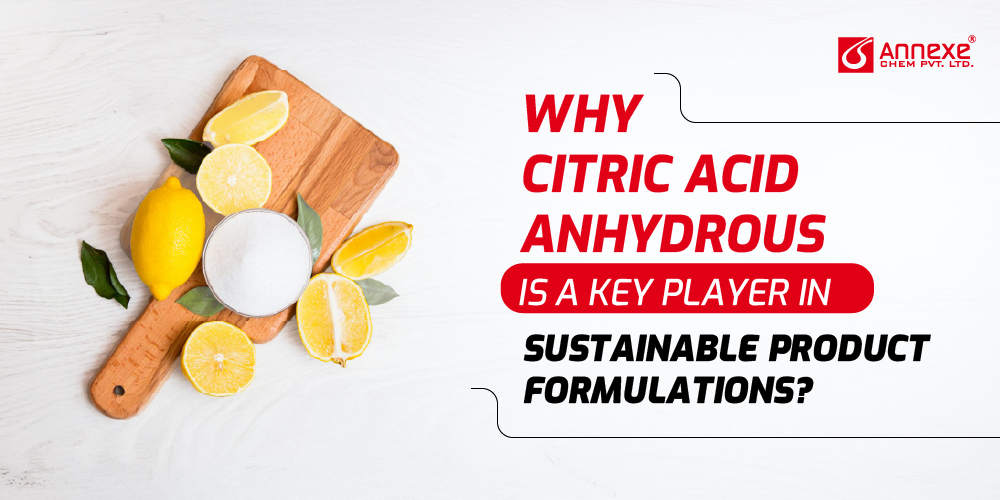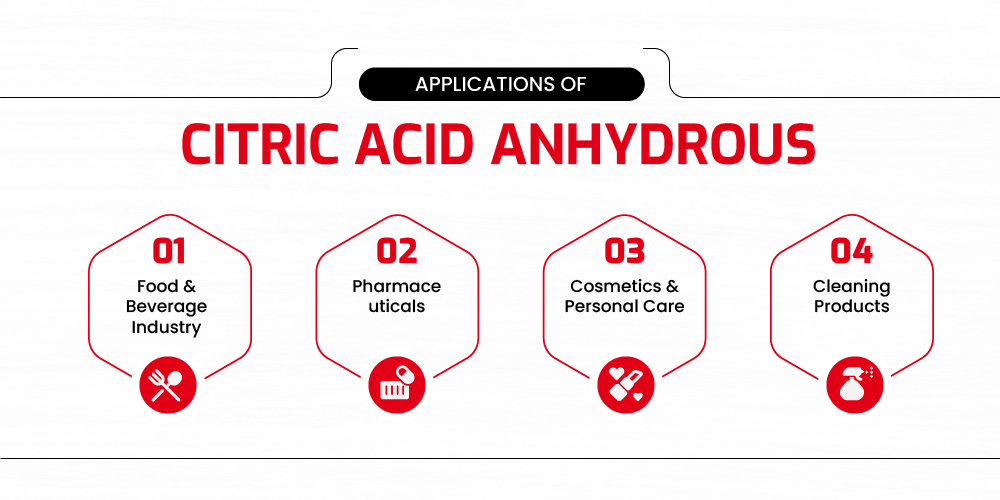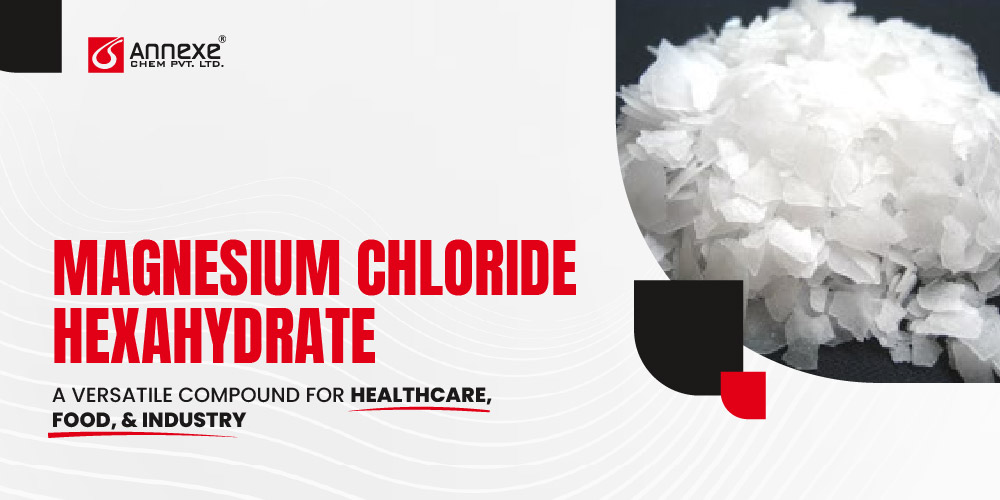Citric Acid Anhydrous in Sustainable Formulations
Why Citric Acid Anhydrous is a Key Player in Sustainable Product Formulations?

- May 12, 2025
- By Akshita Patel
Ever wondered what gives your favorite fizzy drink its tangy kick or keeps your skincare products perfectly balanced? The secret lies in a surprisingly versatile ingredient—citric acid anhydrous. From food and pharmaceuticals to cleaning agents and cosmetics, this powerful compound does far more than just add a sour note. It’s the quiet multitasker behind the scenes, enhancing flavor, preserving shelf life, and stabilizing formulas across industries. But what exactly is citric acid anhydrous, and why is it so widely used?
Let’s break it down and uncover why this odorless, crystalline powder deserves a closer look.
What is Citric Acid Anhydrous?
Citric acid anhydrous is a naturally occurring weak organic acid that is widely used for its acidic properties and ability to chelate metals. It is derived from the same base compound as regular citric acid but exists in a water-free (anhydrous) form. The term “anhydrous” simply means “without water,” making this variant ideal for applications where moisture must be strictly controlled.
Citric acid anhydrous is chemically represented as C₆H₈O₇, the same molecular formula as its monohydrate counterpart. However, unlike citric acid monohydrate, it does not contain any water molecules bound to its structure. This lack of water makes it a more concentrated and stable form of citric acid for many industrial and pharmaceutical applications.
- Chemical Name: 2-hydroxy-1,2,3-propanetricarboxylic acid
- Molecular Formula: C₆H₈O₇
- Molecular Weight: Approximately 192.12 g/mol
- CAS Number: 77-92-9
Physical Characteristics of Citric Acid Anhydrous
Citric acid anhydrous appears as a colorless, odorless crystalline powder with a distinctly sour taste. It is highly soluble in water and alcohol, and it maintains its structure well in dry environments. Its hygroscopic nature means it can absorb moisture from the air, which is why it is typically stored in airtight containers. Key properties include:
- Appearance: Fine, white to colorless crystalline powder
- Odor: Odorless
- Taste: Strongly acidic and tart
- Solubility: Easily soluble in water and ethanol
- pH (1% solution): Approximately 2.2
Key Properties of Citric Acid Anhydrous
Citric acid anhydrous stands out not just for its functionality, but also for its highly stable and adaptable chemical nature. Understanding its key properties helps manufacturers and formulators choose the right form for specific applications, especially in industries where precision, purity, and shelf life are critical.
One of the most defining characteristics of citric acid anhydrous is its acidic nature. When dissolved in water, it forms a strongly acidic solution, typically with a pH of around 2.2 for a 1% solution. This makes it an excellent pH regulator and acidulant in food, beverages, pharmaceuticals, and cosmetics.
- pH (1% aqueous solution): ~2.2
- Solubility in water (at 25°C): ~59g/100mL
- Solubility in ethanol (95%): Slightly soluble
Its high solubility allows for rapid dispersion and easy incorporation into both liquid and dry formulations, making it a popular choice for effervescent products, powdered drink mixes, and cleaning solutions.
Storage Conditions For Citric Acid Anhydrous
To maintain its potency and prevent moisture absorption, citric acid anhydrous should be stored in optimal conditions. As a hygroscopic compound, it readily attracts and absorbs water from the surrounding environment. Recommended storage guidelines:
- Store in a cool, dry place away from moisture and direct sunlight
- Use airtight containers or moisture-resistant packaging
- Keep away from strong oxidizing agents or volatile substances
- Ideal storage temperature: Below 30°C (86°F)
Improper storage can lead to clumping, degradation, or reduced effectiveness, which is particularly critical in pharmaceutical and industrial applications.

Applications of Citric Acid Anhydrous
Thanks to its acidic properties, excellent solubility, and non-toxic nature, citric acid anhydrous plays a critical role in a wide range of industries. From enhancing flavor in foods to acting as a stabilizer in pharmaceuticals, its versatility makes it a staple ingredient across multiple sectors.
Food & Beverage Industry:
In the food and beverage sector, citric acid anhydrous is one of the most commonly used additives. Its sharp, tangy flavor makes it a go-to flavoring agent, especially in products that require a citrus-like taste.
- Flavoring Agent: Adds a refreshing tartness to soft drinks, candies, fruit-flavored snacks, and jellies.
- Preservative: Inhibits the growth of bacteria, yeast, and mold, helping extend shelf life naturally.
- Acidity Regulator: Maintains consistent pH levels in products, ensuring stability, taste, and texture. It’s particularly vital in canned foods and beverages where pH control is crucial for food safety and flavor.
Examples: Carbonated drinks, sour candies, fruit juices, jams, processed cheeses, canned vegetables, and ready-to-drink teas.
Pharmaceuticals:
Citric acid anhydrous is widely used in pharmaceutical formulations due to its stabilizing, buffering, and effervescent properties.
- Excipient and Stabilizer: Helps stabilize active ingredients in tablets, syrups, and topical medications.
- Effervescent Tablets: Reacts with bicarbonates to create a fizzing effect, improving drug palatability and aiding faster dissolution.
- Bioavailability Enhancer: Helps improve solubility and absorption of certain active pharmaceutical ingredients (APIs), boosting their effectiveness.
Its ability to maintain pH and enhance solubility makes it ideal for oral rehydration salts, vitamin supplements, pain relievers, and digestive aids.
Cosmetics & Personal Care:
In cosmetic and personal care formulations, citric acid anhydrous serves both functional and aesthetic purposes.
- pH Adjuster: Ensures that skin and hair care products are neither too acidic nor too alkaline, preventing irritation and maintaining product efficacy.
- Preservative Booster: Helps preserve formulations by controlling microbial growth, especially in combination with other preservatives.
You’ll find it in a wide variety of products, including facial cleansers, moisturizers, shampoos, conditioners, bath bombs, and body scrubs, where it supports product texture and stability.
Cleaning Products:
Citric acid anhydrous is an effective and eco-friendly alternative to harsh chemical cleaners.
- Descaling Agent: Excellent at breaking down limescale, rust, and mineral deposits—ideal for kettles, dishwashers, coffee machines, and bathroom surfaces.
- Eco-Friendly Cleaner: Its biodegradable and non-toxic nature makes it a preferred choice in green cleaning products.
It’s used in formulations for multi-surface sprays, toilet cleaners, dishwasher powders, and hard water stain removers, providing cleaning power without harmful fumes or residues.
Industrial Applications:
Beyond consumer goods, citric acid anhydrous plays a significant role in various industrial and scientific settings.
- Metal Cleaning and Chelation: Binds to metal ions and removes unwanted deposits, making it ideal for metal surface treatment, descaling, and corrosion control.
- Laboratory Use: Frequently used as a buffering agent in chemical and biochemical research, where precise pH levels are crucial.
Its non-toxic profile also makes it a safer alternative to stronger acids in lab and industrial processes, especially where human safety or environmental concerns are a priority.
Whether it’s brightening up your lemonade, powering your vitamin C tablet, or keeping your bathroom spotless, citric acid anhydrous is the quiet hero behind countless everyday products. Its unmatched versatility, safety, and efficiency make it a cornerstone ingredient across industries—from the lab bench to the kitchen shelf.
Sustainability and Market Trends
In today’s environmentally conscious world, citric acid anhydrous is gaining attention not just for its functionality but also for its alignment with sustainable and eco-friendly practices. As industries move away from synthetic chemicals, the demand for naturally derived, biodegradable ingredients is rising, and citric acid anhydrous fits perfectly into this green narrative.
Growing Demand for Bio-Based and Natural Ingredients:
Consumers are increasingly seeking out products with clean labels and recognizable ingredients. As a naturally occurring organic acid, typically produced through fermentation of renewable resources like molasses or corn starch, citric acid anhydrous answers the call for bio-based, plant-derived components.
- Widely accepted in organic and natural product lines across food, cosmetics, and home care sectors
- Meets global demand for non-toxic, allergen-free, and environmentally friendly formulations
- Supports the shift toward minimalist and transparent ingredient lists
This trend is especially prominent in industries like personal care and cleaning products, where harsh synthetic chemicals are being phased out in favor of greener alternatives.
Role in Sustainable Product Formulations:
Citric acid anhydrous contributes to sustainability in several ways:
- Biodegradability: Breaks down naturally without polluting water sources or harming ecosystems
- Non-Toxicity: Safe for human use and handling across food, pharma, and household applications
- Low Environmental Impact: Produced using renewable feedstocks through fermentation, which requires less energy and creates fewer emissions than petrochemical-based ingredients
Because of its multi-functional properties, manufacturers can often reduce the number of ingredients in a formula, simplifying production and improving sustainability profiles.
Market Forecast and Emerging Applications: The global citric acid market—driven in large part by the anhydrous form—is poised for continued growth. As of recent reports:
- Market Size: Valued at over $3 billion, with projections estimating steady growth through 2028 and beyond
- Key Drivers: Rising demand in functional foods, natural cleaning agents, and eco-friendly cosmetics
- Emerging Applications: Use in biodegradable packaging materials, green solvents, and water treatment is gaining traction
In the pharmaceutical and nutraceutical sectors, citric acid anhydrous is also being explored in next-generation drug delivery systems due to its solubility-enhancing capabilities.
Citric acid anhydrous is far more than just a common ingredient—it’s a versatile, sustainable powerhouse used across industries. From enhancing flavor and preserving freshness in foods to boosting stability in pharmaceuticals and replacing harsh chemicals in cleaning products, its applications are broad and growing. With the added advantage of being biodegradable and derived from renewable resources, it aligns perfectly with the global shift toward greener, safer, and more transparent formulations.
Looking to incorporate high-quality citric acid anhydrous into your formulations? Connect with Annexe Chem Pvt Ltd today to explore sourcing options, technical support, and tailored solutions for your industry needs.
Let’s build cleaner, smarter, and more sustainable products—together.

Akshita Patel
As an advocate for sustainability, Akshita is committed to driving positive change within the chemical industry. She actively seeks out environmentally friendly solutions and promotes the adoption of sustainable practices. Akshita believes that a balance between economic growth and ecological responsibility is crucial for the industry's long-term success. She is dedicated to finding innovative ways to minimize environmental impact while maximizing efficiency and profitability.
Related Blogs

- February 4, 2025
- By Akshita Patel
Magnesium Chloride Hexahydrate: A Versatile Compound.
From industrial applications to personal health, Magnesium Chloride Hexahydrate is a powerhouse compound with a wide.

- January 13, 2025
- By Akshita Patel
From Food to Industry: The Versatile.
Did you know that a simple compound found in berries and certain plants plays a vital.



